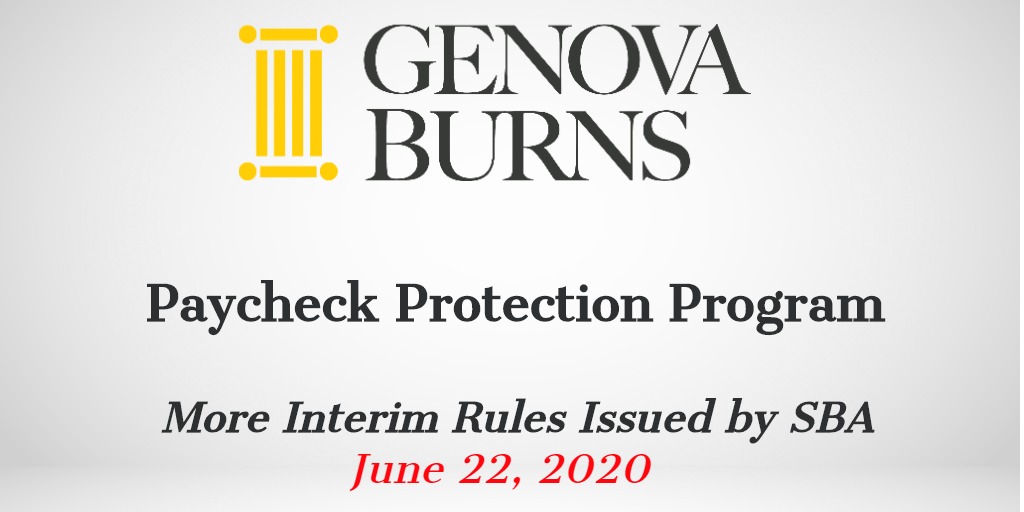Paycheck Protection Program: More Interim Rules Issued by SBA
New Rules to Align with the Flexibility Act; Implications of EID Loans for Payroll Costs
June 24, 2020 | By: Keith A. Krauss, Esq.
On June 22, 2020, the SBA issued another set of interim final rules to conform earlier issued rules with the Paycheck Protection Program Flexibility Act of 2020 (the “Flexibility Act”). Specifically, these rules revise the interim final rules issued on June 1, 2020 regarding loan forgiveness and the SBA’s loan review procedures.
These rules:
- Incorporate both forms of the loan forgiveness application released by the SBA and the Treasury Department, including the EZ form, as well as a ‘lender equivalent’ form.
- Provide that if a borrower does not apply for forgiveness of a loan within 10 months after the last day of the applicable loan forgiveness covered period, the PPP loan is no longer deferred and the borrower must begin paying principal and interest. Note that the rules state that if a borrower applies for forgiveness before the end of the covered period (e.g. during the 24-week loan forgiveness covered period, and the borrower reduced one or more employee’s salaries or wages in excess of 25%, the borrower must account for the excess salary reduction for the full loan forgiveness covered period.
- Incorporate the 24-week loan forgiveness period for purposes of determining when payroll costs incurred and/or paid during the requisite covered period are eligible for forgiveness. The availability of the alternative payroll covered period, which permits businesses with a bi-weekly (or more frequent) payroll cycle to start their payroll covered period on the first day of the first payroll cycle after receipt of loan funds, remains unaffected.
- Clarify the cap on loan forgiveness with respect to owner-employees and self-employed individuals, such that owner-employees and self-employed individuals may not seek forgiveness for their own replacement compensation in excess of $15,385 per individual for borrowers eligible for, and electing, the 8-week covered period, and $20,333 for borrowers utilizing the 24-week covered period (in total across all businesses). Their respective owner replacement compensation must be based on their 2019 compensation, as supported by their Schedule C or F filings.
- Incorporate the 24-week loan forgiveness period for purposes of determining when eligible nonpayroll costs incurred and/or paid during the requisite covered period are eligible for forgiveness.
- Incorporate the additional exemptions introduced in the Flexibility Act, such that workforce reductions which cannot be restored due to specific circumstances affecting the borrower (e.g. inability to re-hire or replace furloughed employees or inability to resume business at same levels as that maintained prior to February 15, 2020).
- Address whether the previously issued guidance regarding the exemptions from loan forgiveness reduction due to refusal of employee to return (or refusal to restore reduction in hours) would be impacted by the Flexibility Act. That is, the borrowers may continue to exclude any reduction in full-time equivalent employee headcount where an employee refused to return, provided that the conditions prescribed in such earlier regulations are satisfied.
- Provide an example of how the SBA would treat the exemption based on business activity levels, indicating a willingness to permit businesses impacted by a local government’s shut-down order due to COVID-19 guidance issued by the Centers for Disease Control and Prevention in March 2020 (e.g. they had to close their stores during the covered period) to discount (exclude) their workforce reductions during the covered period. Note, if the business restored its business activity levels at the end of the covered period, it may not be eligible for the exemption. Borrowers are advised to review their business activity levels over the course of the covered period.
- Provide guidance as to what information and documents lenders are required to review upon receipt of the Form 3508 or Form 3508EZ loan forgiveness applications from borrowers, while reaffirming borrowers’ responsibility to provide accurate calculations of the loan forgiveness amount.
In addition, the SBA and Treasury Department released a Procedural Notice, providing guidance on the mechanics for refinancing that portion of the Economic Injury Disaster Loan (EIDL) with the Paycheck Protection Program (PPP) loan. Earlier in the launching of the Paycheck Protection Program, borrowers were encouraged to apply for the EIDL and the Paycheck Protection Programs, with a caveat that EIDL funds may not be used to pay for the same purposes.
This procedural notice provides that:
- EIDL funds received prior to January 31, 2020 or after April 3, 2020 are ineligible for refinancing with a PPP loan.
- EIDL funds must be refinanced with the PPP loan, if the EIDL funds were received between January 31, 2020 and April 3, 2020 (inclusive), and the EIDL funds were used to pay payroll costs.
- An EIDL loan need not be refinanced with the PPP loan where the EIDL loan was used for purposes other than payroll costs.
- The EIDL loan amount that needs to be refinanced excludes the amount of any EIDL advance (grant funds not exceeding $10,000)*.
*Note that the EIDL advance (grant) impacts the loan forgiveness amount (reduces the loan forgiveness amount). In the loan forgiveness applications, it expressly states that the “SBA will deduct EIDL Advance Amounts from the forgiveness amount remitted to the Lender.”
Lastly, an additional interim final rule was released today, June 24, 2020, relaxing earlier restrictions on eligibility for businesses which a 20% (or more) owner was subject to criminal proceedings. Note that businesses where “[a]n owner of 20 percent or more of the equity interests is presently incarcerated or, for any felony, presently subject to an indictment, criminal information, arraignment, or other means by which formal criminal charges are brought in any jurisdiction, or has been convicted of, pleaded guilty or nolo contendere, or commenced any form of parole or probation (including probation before judgment) for, a felony involving fraud, bribery, embezzlement, or a false statement in a loan application or an application for federal financial assistance within the last five years or any other felony within the last year” would remain ineligible. Applicants are advised to review these rules, the First Interim Rules, and the Additional Revisions to the First Interim Final Rule released on June 18, 2020 in determining their eligibility in connection with any criminal proceedings/matters affecting a 20+ percent owner.
For additional guidance on the Paycheck Protection Program, please contact firm Counsel Keith A. Krauss via email, Associate Young-Ji Park via email or call 973.535.4441.
Tags: Genova Burns LLC • Keith A. Krauss • Young-Ji Park • PPP • Paycheck Protection Program • SBA • COVID-19 • Small Business Administration


